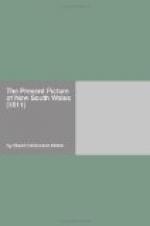From the above statements it will most certainly appear, that the colony is in a very flourishing state, and, no doubt, will soon become independent of the mother country, if those methods are pursued which are best calculated to promote this end. No one step has latterly been taken to facilitate this desirable object more than the measures adopted by Colonel Johnstone and Lieutenant-Governor Foveaux, who distributed the breeding cattle amongst the industrious and deserving settlers; a step which has produced benefits of a two-fold nature—laying the foundation for the more rapid increase of stock, and affording a stimulus to meritorious exertion. In the districts about Hawkesbury, the grain yields abundantly; but at the other settlements it is less productive: The reason of this distinction must be chiefly obvious to the reader of the preceding sketch, in the liability of the soil at the former settlement to frequent inundations, which serve every purpose of manure, and uniformly keep the ground in a mellow state. It has been erroneously stated, that the average produce of the land in New South Wales is sixty bushels of wheat per acre; but I can take upon myself to say, that twenty-five bushels an acre will be found the full extent of the average produce. When a comparison is made between the present state of the country and its former condition, the improvements will appear considerable in agriculture, and almost incredible in every other respect. The season for the gathering in of the wheat has been gradually accelerated, ever since the commencement of the colony; and the harvest of the last year previous to my departure from the settlement, commenced nearly a month sooner than it did at the first: The fruit seemed also later.
Prices of Provisions, and Ration.
The following was the current price of Articles of Food, in the year 1809:—Wheat 12s. per bushel; maize 5s. per bushel; barley 5s. per bushel; oats 4s. 6d. per bushel; potatoes 10s. per cwt.; turnips 4d. per bunch; carrots 6d. per bunch; cabbages 3d. each; lemons 6d. per dozen; peaches 2d. per dozen; apples 2s. per dozen; pears 3s. per dozen; strawberries 1s. per quart; quinces 2s. per dozen; water melons 9d. each; musk and other melons 1s. each; apricots 1s. per dozen; mulberries 1s. per quart; Cape gooseberries 8d. per quart; native currants 8d. per quart; oranges, raspberries, grapes, plums, almonds, pomegranates, limes, shaddocks, citrons, pine-apples, nectarines, and guavas, are to be procured; but their prices are variable, some of them being more scarce than others. Cucumbers 1d. each, mushrooms 8d. per quart, French beans 4d. per quart, onions 20s. per cwt. peas 1s. per quart, beans 9d. per quart, asparagus 2s. per hundred, artichokes 6d. each, spinage 1s. per dish, pumpkins 6d. each, cauliflowers 6d. each, brocoli 6d. per dish, figs 3d. per dozen. Beet-root, lettuces, raddishes, sallad of all kinds, horse-raddish, samphire, watercresses, celery, endive, and herbs of every description, are extremely plentiful, and to be purchased at reasonable rates.




